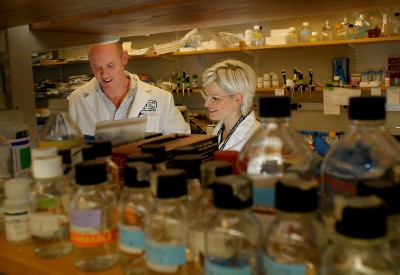BRI Advances Research Despite Challenging Economy

Postdoctoral fellows Trevor Siggers, PhD, and Karin Hellner, MD, serve on the Research Advisory Committee that is leading efforts to develop BWH’s new Postdoc Policy.
The Biomedical Research Institute (BRI) has an impassioned mission: accelerating the pace of scientific discovery by fostering groundbreaking and interdisciplinary research among the hospital’s research community, as well as providing a clear voice both within the hospital and outside its walls for all researchers at BWH.
Since forming in 2005 by bringing the hospital’s entire research enterprise under one administrative umbrella, the BRI has brought together the research community around an increasing number of core services and a wide array of administrative resources. Securing funding for these resources and research opportunities remains a top priority, especially in recent years as a troubled economy has led to decreased funding opportunities.
Despite the challenges in the economy, BWH has maintained its place as one of the nation’s leading research institutions. BWH and Massachusetts General Hospital rank at the top of the largest free-standing hospitals that receive funding from the National Institutes of Health, with MGH ranking first and BWH second in each of the last 10 years.
Research dollars at BWH amounted to $485 million in fiscal year 2009, which ended in September, an increase of $32 million from the previous year. This number accounts for approximately 23.5 percent of all hospital spending in that fiscal year.
“For the last 12 years, research has been between 20 percent and 25 percent of all hospital expenditures,” said Barbara Bierer, MD, senior vice president of Research and director of Faculty Development and Diversity. “This is a clear demonstration of our commitment to research and maintaining our academic standing.”
BWH ranks in the top 20 recipients of funding from the American Recovery & Reinvestment Act of 2009, or so-called ARRA grants. The hospital has received 169 ARRA grants totaling more than $97 million. These two-year grants awarded to BWH cover a wide variety of research, including projects in sleep medicine, neurology, cardiology, genetics, women’s health and pharmacoepidemiology, among others. This success comes on the heels of a BRI-sponsored research town meeting, which drew a standing-room only crowd to the Bornstein Amphitheater, and up-to-date resources made available on the Research Intranet.
The BRI funded three new and exciting research projects in the last year, too.
The Center for Human Genetics’ OurGenes pilot project will involve collecting and archiving DNA samples from 600 BWH patients along with their personal and family health history. Following experience gained from the pilot, OurGenes will expand to include all BWH patients and integrate with the Partners Personalized Medicine Biobank.
The Phenogenetic project, jointly sponsored by the Infectious and Immunologic Diseases Research Center and the Center for Human Genetics, provides a source of fresh and stored biological samples from human subjects and an electronic atlas that references the expression of genes to the variation found within those genes.
The Cardiovascular, Diabetes and Metabolic Disorders Center is developing a CVDM tissue repository as a resource to strengthen the working relationships between scientists and clinicians and to foster more in-depth research and collaboration among basic, translational and clinical investigators.
With the BWH Research Oversight Committee’s department representatives and center co-chairs, the BRI is moving ahead with four new strategic themes and priorities in the coming year. “BWH patients are our partners in the future of health care,” BRI Director Cynthia Morton, PhD, said.
That partnership is the driving force behind four strategic themes in place for the coming year:
Common Mechanisms of Disease
Personalized Medicine
Targeted Therapeutics
Comparative Effectiveness
In coming months, leaders of each of the BRI’s centers and programs will be charged with identifying a few priority opportunities within each group that fit into one of the strategic themes and serve as a bridge across departments, Morton said.
“Perhaps there’s a diagnostic test that’s poised for development,” said Morton. Beginning in December, task forces will come together to define each theme better and plan further how to integrate clinical research opportunities for the themes across departments. “Each task force will come together around each theme—under one overarching theme of disparities in health care.”
Learn more about the BRI and its leadership